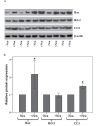Angiogenin is upregulated during the alloreactive immune response and has no effect on the T-cell expansion phase, whereas it affects the contraction phase by inhibiting CD4+ T-cell apoptosis
- PMID: 27882181
- PMCID: PMC5103843
- DOI: 10.3892/etm.2016.3786
Angiogenin is upregulated during the alloreactive immune response and has no effect on the T-cell expansion phase, whereas it affects the contraction phase by inhibiting CD4+ T-cell apoptosis
Abstract
Under growth conditions, angiogenin is translocated into the nucleus, where it enhances ribosomal RNA transcription, facilitating increased protein synthesis and cellular proliferation. During stress conditions, angiogenin is sequestered in the cytoplasm, where it cleaves transfer RNA (tRNA) to produce tRNA-derived, stress-induced small RNAs (tiRNAs) that inhibit global protein synthesis, but increase the translation of anti-apoptotic factors. In the present study, the role of angiogenin in the human alloreactive immune response was evaluated using mixed lymphocyte reactions (MLRs) and neamine, an inhibitor of angiogenin nuclear translocation. In MLRs, angiogenin production was significantly (P<0.001) increased compared with resting peripheral blood mononuclear cells. The addition of neamine had no effect on cell proliferation, but did significantly (P<0.001) increase expression of Bcl-2-associated X protein and protein levels of activated caspase-3 in CD4+ T-cells isolated from the MLRs, indicating that angiogenin reduces apoptosis. In conclusion, angiogenin is upregulated during the alloreactive immune response, in which it does not affect the T-cell expansion phase, but inhibits the T-cell contraction phase by protecting against CD4+ T-cell apoptosis.
Keywords: angiogenin; apoptosis; cluster of differentiation 4 positive T-cells; proliferation.
Figures




Similar articles
-
Angiogenin cleaves tRNA and promotes stress-induced translational repression.J Cell Biol. 2009 Apr 6;185(1):35-42. doi: 10.1083/jcb.200811106. Epub 2009 Mar 30. J Cell Biol. 2009. PMID: 19332886 Free PMC article.
-
Angiogenin and tRNA fragments in Parkinson's disease and neurodegeneration.Acta Pharmacol Sin. 2020 Apr;41(4):442-446. doi: 10.1038/s41401-020-0375-9. Epub 2020 Mar 6. Acta Pharmacol Sin. 2020. PMID: 32144338 Free PMC article. Review.
-
Neamine is preferential as an anti-prostate cancer reagent by inhibiting cell proliferation and angiogenesis, with lower toxicity than cis-platinum.Oncol Lett. 2015 Jul;10(1):137-142. doi: 10.3892/ol.2015.3227. Epub 2015 May 19. Oncol Lett. 2015. PMID: 26170989 Free PMC article.
-
In human alloreactive CD4⁺ T-cells, dichloroacetate inhibits aerobic glycolysis, induces apoptosis and favors differentiation towards the regulatory T-cell subset instead of effector T-cell subsets.Mol Med Rep. 2016 Apr;13(4):3370-6. doi: 10.3892/mmr.2016.4912. Epub 2016 Feb 19. Mol Med Rep. 2016. PMID: 26935268
-
tiRNAs: A novel class of small noncoding RNAs that helps cells respond to stressors and plays roles in cancer progression.J Cell Physiol. 2020 Feb;235(2):683-690. doi: 10.1002/jcp.29057. Epub 2019 Jul 8. J Cell Physiol. 2020. PMID: 31286522 Review.
Cited by
-
Transcriptomic analysis of glucosidase II beta subunit (GluIIß) knockout A549 cells reveals its roles in regulation of cell adhesion molecules (CAMs) and anti-tumor immunity.BMC Genomics. 2024 Jan 20;25(1):82. doi: 10.1186/s12864-023-09888-z. BMC Genomics. 2024. PMID: 38245670 Free PMC article.
-
Aberrant expression of interleukin-23-regulated miRNAs in T cells from patients with ankylosing spondylitis.Arthritis Res Ther. 2018 Nov 21;20(1):259. doi: 10.1186/s13075-018-1754-1. Arthritis Res Ther. 2018. PMID: 30463609 Free PMC article.
-
The differential proteomic response to ischemic stroke in appalachian subjects treated with mechanical thrombectomy.J Neuroinflammation. 2024 Aug 17;21(1):205. doi: 10.1186/s12974-024-03201-9. J Neuroinflammation. 2024. PMID: 39154085 Free PMC article.
-
Osteoclasts protect bone blood vessels against senescence through the angiogenin/plexin-B2 axis.Nat Commun. 2021 Mar 23;12(1):1832. doi: 10.1038/s41467-021-22131-1. Nat Commun. 2021. PMID: 33758201 Free PMC article.
-
SLFN2 protection of tRNAs from stress-induced cleavage is essential for T cell-mediated immunity.Science. 2021 May 14;372(6543):eaba4220. doi: 10.1126/science.aba4220. Science. 2021. PMID: 33986151 Free PMC article.
References
LinkOut - more resources
Full Text Sources
Other Literature Sources
Research Materials
